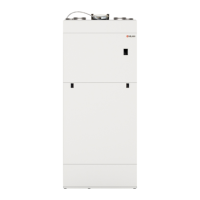17
Positioning an outdoor unit
An outdoor unit must always be positioned on a firm, horizontal and vibration free surface. Consider securing it to a fixed base. You
should also take into account the prevailing wind direction during the cold months when heating is required, as the performance of the
heat pump will be reduced if the outdoor unit is exposed to strong winds.
Fixing an outdoor unit to its supporting surface
If you place the outdoor unit in a windy location, e.g. on a roof, you will need to fix it to the supporting surface by using the 6 pre-drilled
holes at the bottom.
If required, you can consider putting up a windbreak. How-
ever, clearance requirements must be met.
Shown below are the horizontal minimum distances to build-
ing parts and sim. that are required for the heat pump to per-
form properly.
If you want to position AIR up against the building, it is impor-
tant that you take into account potential noise from the out-
door unit so it does not become a cause of irritation indoors.
Position AIR so air is supplied from the dwelling. The air gains
added energy from solar heating of the building walls during
the day and from general heat loss from the building. This can
then improve the efficiency of the heat pump.
AIR outdoor unit seen from below: AIR outdoor base plate:
ATTENTION
The illustrations above show an example of an AIR outdoor unit. The outdoor unit is available in different versions. See
the dimensional drawing for details.
Compressor unit
Pre-drilled holes

